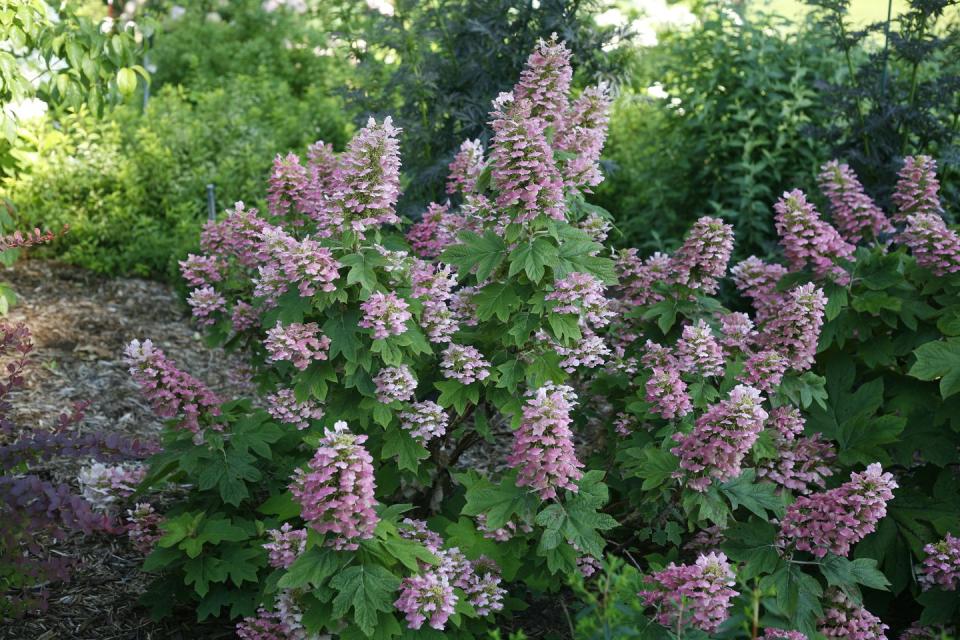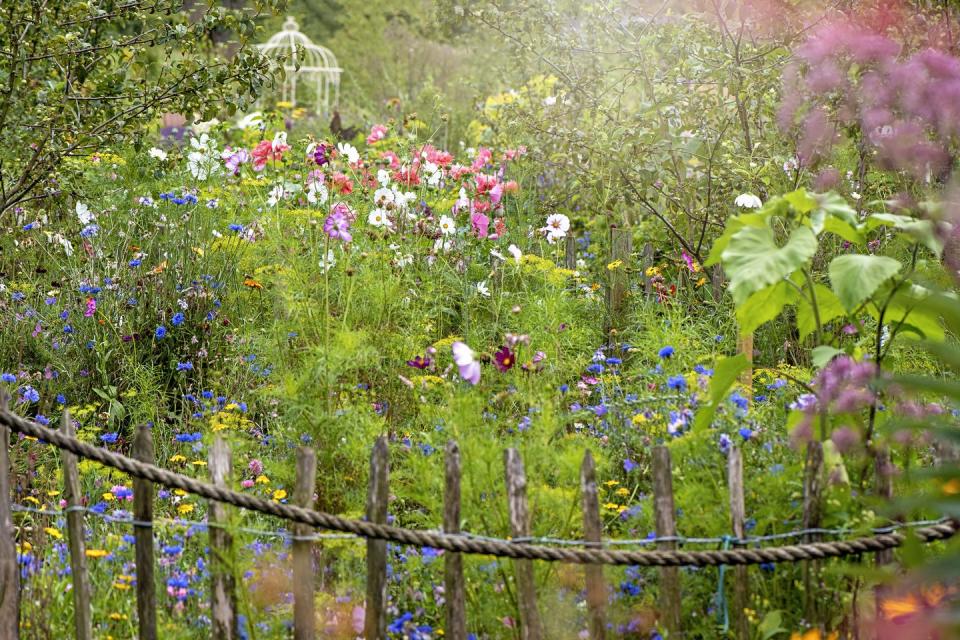What is ‘Nostalgia Gardening’— And Why You Should Try It

"Hearst Magazines and Yahoo may earn commission or revenue on some items through these links."
In recent years, nostalgia has been the dominating force in the world of interior design. Whether it’s vintage decorating trends making a comeback (hello, knotty pine paneling) or the newfound interest around cozy, collected interiors, you can hardly pick up a design magazine or scroll through Instagram without enjoying a trip down memory lane. Pastel bathroom tile? Yep. Butter yellow kitchens? Bring it.
For the record, we are very much here for this.
Given this obsession with nostalgia, it should come as no surprise that the world of garden design is following suit. As of late, a similar in-with-the-old approach is taking root in outdoor spaces, with both experienced and novice gardeners looking to conjure the lived-in and layered feeling—and fragrances!—of the gardens they remember growing up. Known as “Nostalgia Gardening,” this trend (if you can even call it that) infuses sentimentality into the soil, with flowers and fragrances intended to transport you to another place and time.
“I think Nostalgia Gardening is part of a larger trend that’s coming with increased interest in reconnecting with nature and slowing down to appreciate the little things,” says Kate Spirgen, Marketing Communications Manager at popular gardening brand Proven Winners. “Cottagecore décor, homesteading, the slow food movement—all of these trends signify a desire to reconnect with the past and get our hands dirty again.”
Kate also points out how Nostalgia Gardening intersects with other recent garden trends including Cottage Gardening, which evokes the classic English countryside, and Chaos Gardening, with its fun, laid-back, experimental approach that reminds us of the fearlessness of childhood.
Sometimes it’s not even the plants that spark memories—rather, it’s the process of gardening itself. “The simple practice of digging in the dirt can bring back memories of time spent with loved ones,” says Country Living’s resident expert gardener Charlyne Mattox.

What is Nostalgia Gardening, Exactly?
“There are a few ways to think about Nostalgia Gardening,” says Proven Winners’ Kate Spirgen. “For some, Nostalgia Gardening can mean creating a green space that reminds them of a place from their childhood. For others, it may simply involve including their grandmother’s favorite flower or their mother’s favorite herb. And for others, it can mean transforming their yard into an old English rose garden.” (The latter of which may tap into a phenomenon called “anemoia,” which refers to longing or feeling nostalgic for a past time you never actually experienced.)
“For me, it is not just a style but a soulful practice of reviving the landscapes of childhood, where each element is chosen not only for its beauty but also for its ability to evoke a sense of belonging and wonder,” says Clare Horne, owner of The Grass Girl, a boutique woman-owned landscape, garden, and outdoor living design company in Nashville, Tennessee. “It’s a way to honor the enduring legacy of gardens that have nurtured generations, inviting us to slow down and savor each moment as a timeless connection between our history and our everyday lives. They’re rooted in memory.”
“I think of gardening for the senses,” says gardening and design expert James Farmer. “To see, taste, smell, touch and hear—each element of the garden can take you to a memory or place that evokes emotion and nostalgia.”
You could say they’re firmly planted in the future, too. “When I hear the phrase “Nostalgia Gardening,” I think of a “Legacy Garden,” meaning a garden to be passed down to the next generation,” says Daniel McCurry, co-founder, CEO, and garden designer for Father Nature Landscapes of Birmingham, Alabama. It makes sense, of course. The more emotionally tied we feel to the landscape, the more compelled we’ll feel to maintain it for future generations.
Five Key Features of a Nostalgia Garden
Want to give this style of gardening a go? Here are a few elements to explore.
1. Sentimental Scents

“Since scent is so closely tied to memory, fragrant plants like roses, lilacs, and lavender evoke nostalgia,” says Kate Spirgen, who adds that lilacs are the most nostalgic plant in her own garden because the lilac has always been her mom’s favorite. “My family moved around a lot when I was young, but my dad would always plant a lilac bush when we settled into a new house. Every spring, I would cut a bouquet for Mother’s Day, so the smell always brings back happy memories from my childhood,” she says.
Kate also adds that modern gardeners get to enjoy the nostalgic benefits of their favorite flowers without many of the challenges that older varieties brought to the garden. “For example, the Bloomerang series of lilacs offers that lovely lilac fragrance with improved disease resistance and stronger rebloom,” says Kate. Similarly, since roses are a popular choice for Nostalgia Gardening, Kate points toward the Reminiscent Coral Rose as a perfect example of a rose that comes with less baggage than petals past. “Not only does it bloom all season without deadheading, but the dark green foliage also stays clean and healthy without any help.”
RELATED: 25 Intoxicatingly Fragrant Plants for Your Garden
2. Familiar Flowers (and Vegetables)

“Nostalgia Gardening reminds me of plants and flowers that my parents grew when I was a child and now I find myself wanting to grow,” says home gardener Jody Gabara (@rootedinthyme). “My mother was very proud of her rose garden so to this day, I have several areas in my garden blooming with roses that always remind me of her.”
Clare Horne also says certain flowers represent different parts of her life: “Plants have always been like chapters in a living storybook for me, each one carrying memories of days gone by.” She’s especially drawn to alliums. “Their striking, architectural blooms remind me of the joy of communal celebrations in sunlit meadows.”
For Daniel, that sentimental stem is the iris. “We didn’t learn much about irises in my Auburn Horticulture program, but the plant—specifically the bearded Iris—always reminds me of my grandmother, Mama-tine, who had me moving plants around, renewal pruning, and thinning at the young age of 1o.”
It’s not just flowers that spark fond memories. Clare says some of her clients lean toward “edible gardens that harken back to those playful afternoons spent with their parents, when the simple joy of planting and harvesting was the day’s greatest adventure.”
3. Wildflowers, Especially

In addition to lilacs, roses, and other popular plantings, multiple experts cite wildflowers as a key component of a Nostalgia Garden. That’s partly because wildflowers remind us of the whimsical days of childhood—making daisy chains, constructing flower crowns, bringing home handpicked bouquets.
“Rudbeckia, with its sunny, bold faces, recalls the carefree exuberance of childhood adventures in fields ablaze with color,” says Clare Horne, who adds that Culver’s root, purple echinacea, and liatris blazing star are also vibrant additions to the landscape. “Together, these plants do more than simply beautify a garden; they create a vibrant collage of memory and emotion.”
4. A Layered, Lived-in Look

There are some gardens that take pride in their exactness—think meticulously sculptured hedges, satisfyingly symmetrical plantings, paths laid out with precision, nary a pebble of pea gravel out of place. This is not that. In fact, Nostalgia Gardens are more in keeping with the beloved cottage garden, a more jumbled, happenstance style of gardening that grew out of necessity, when English peasants used every inch of their land to grow just a little of everything— fruits, vegetables, herbs, flowers—to feed their families and make the most of their literal lot in life. If the formal garden is a realist painting, the Nostalgia Garden is more abstract, with misplaced thrivers and blurred borders. The happy chaos is a reminder that, despite our best-laid plans, life goes on—and sometimes plants need to let loose, too.
Similarly, homeowners are skipping clean-lined matching sets of outdoor furniture and opting for more of a mix-and-match, acquired-over-time feeling. “My clients are increasingly moving away from modern, minimalist aesthetics and are instead embracing traditional furniture designs,” says Clare. “Pieces crafted from warm teak wood and custom wrought-iron not only provide functional seating and accents but also carry a heritage of design that complements the organic textures of nature.”
5. Not-So-New Hardscaping

By now you can probably envision what structural elements feel at home in a Nostalgia Garden. “Winding walkways, stepping stones, and pathways are classic elements that encourage meandering at a leisurely pace. Other classic elements like garden benches, bird baths, and trellises add interest and encourage reflection,” says Kate.
Daniel adds that this style of gardening calls to mind “antique troughs, limestone tables, copper gas lanterns, garden gates of cast iron or painted wood, and other pieces of statuary, as well as solid wood, molded brick, and cleft stone (not thermaled or other mechanically textured finishes).”
Clare also says she’s seen a resurgence in water fixtures. “A softly bubbling fountain or a serene pond does more than reflect light; it creates a meditative sanctuary, where the gentle sound of water transports you back to a time when life was savored at a slower pace.”
Whatever additions you choose to make, take heart that when decisions are intertwined with soul and sentiment, they’ll never fall out of favor. Says Clare: “This isn’t just a fleeting trend—it’s a heartfelt response to our need for peace, presence, and a renewed connection to our past.”
You Might Also Like

 Yahoo Lifestyle
Yahoo Lifestyle 
